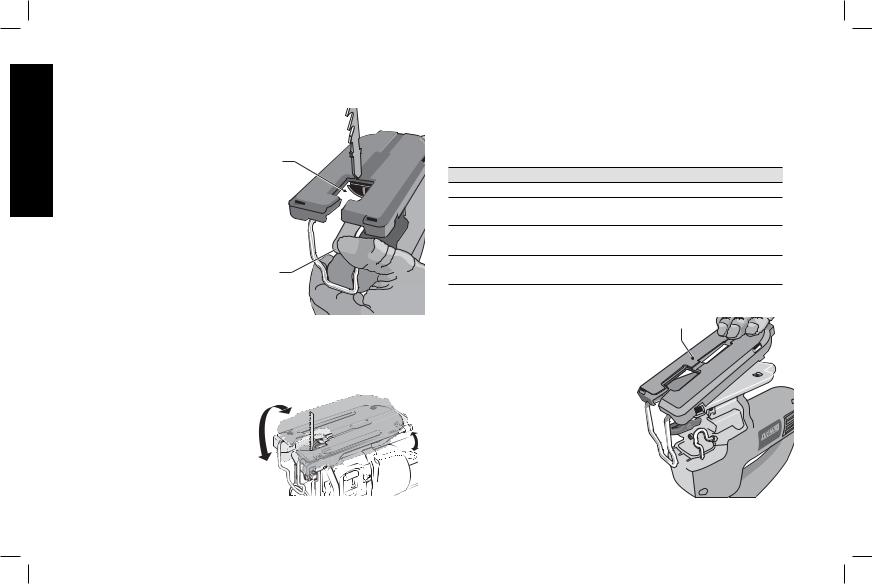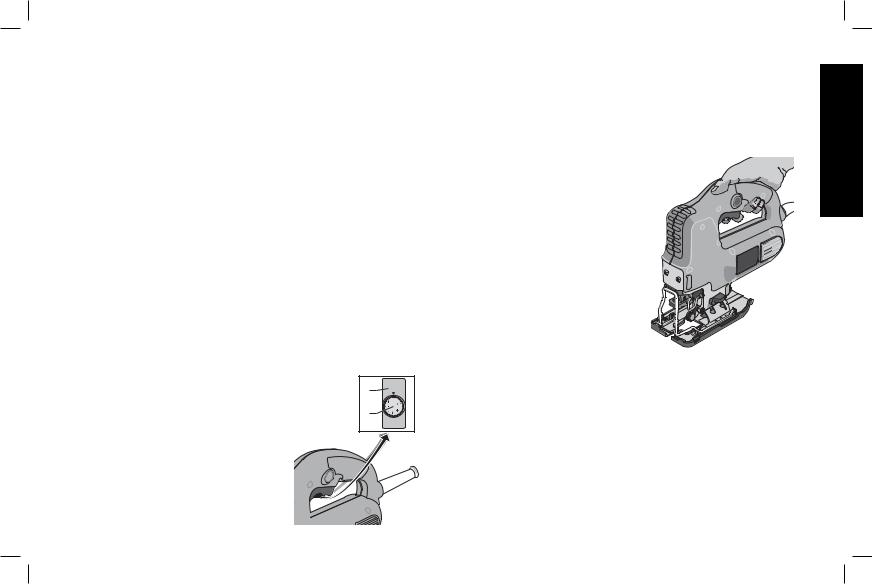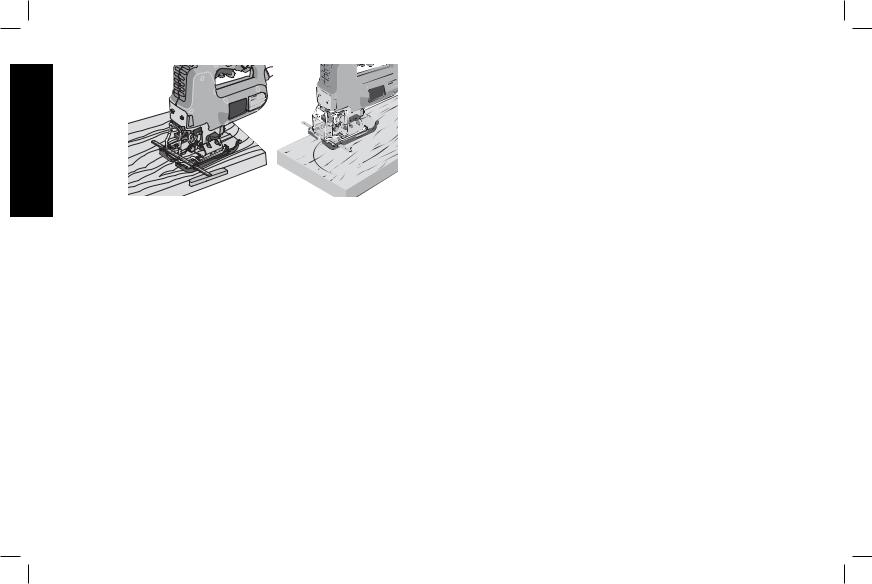Dewalt DW341 User Manual

Questions? See us on the World Wide Web at www.dewalt.com ¿Dudas? Visítenos en Internet: www.dewalt.com
Dúvidas? Visite-nos na Internet em www.dewalt.com.br
INSTRUCTION MANUAL MANUAL DE INSTRUCCIONES MANUAL DE INSTRUÇÕES
INSTRUCTIVO DE OPERACIÓN, CENTROS DE SERVICIO Y PÓLIZA DE GARANTÍA. ADVERTENCIA: LÉASE ESTE INSTRUCTIVO ANTES DE USAR EL PRODUCTO.
INSTRUÇÕES DE OPERAÇÃO, CENTRO DE SERVIÇOS E CERTIFICADO DE GARANTIA. ADVERTÊNCIA: LEIA ESTAS INSTRUÇÕES ANTES DE UTILIZAR O PRODUTO.
DW341
VS Orbital Jig Saw 3/4" (20 mm) Stroke Sierra Caladora Orbital VV 20 mm (3/4") CPM
Serra Tico-Tico VV e Ação Orbital Comprimeto do Golpe 20 mm (3/4")

English
Definitions: Safety Guidelines
The definitions below describe the level of severity for each signal word. Please read the manual and pay attention to these symbols.
 DANGER: Indicates an imminently hazardous situation which, if not avoided, will result in death or serious injury.
DANGER: Indicates an imminently hazardous situation which, if not avoided, will result in death or serious injury.
 WARNING: Indicates a potentially hazardous situation which, if not avoided, could result in death or serious injury.
WARNING: Indicates a potentially hazardous situation which, if not avoided, could result in death or serious injury.
 CAUTION: Indicates a potentially hazardous situation which, if not avoided, may result in minor or moderate injury.
CAUTION: Indicates a potentially hazardous situation which, if not avoided, may result in minor or moderate injury.
CAUTION: Used without the safety alert symbol indicates a potentially hazardous situation which, if not avoided, may result in property damage.
General Safety Instructions
WARNING! Read and understand all instructions. Failure to follow all instructions listed below, may result in electric shock, fire and/or serious personal injury.
SAVE THESE INSTRUCTIONS
WORK AREA
•Keep your work area clean and well lit. Cluttered benches and dark areas invite accidents.
•Do not operate power tools in explosive atmospheres, such as in the presence of flammable liquids, gases, or dust.
Power tools create sparks which may ignite the dust or fumes.
•Keep bystanders, children, and visitors away while operating a power tool. Distractions can cause you to lose control.
ELECTRICAL SAFETY
•Grounded tools must be plugged into an outlet properly installed and grounded in accordance with all codes and ordinances. Never remove the grounding prong or modify the plug in any way. Do not use any adaptor plugs. Check with a qualified electrician if you are in doubt as to whether the outlet is properly grounded. If the tools should electrically malfunction or break down, grounding provides a low resistance path to carry electricity away from the user. Applicable only to
Class I (grounded) tools.
•Double insulated tools are equipped with a polarized plug (one blade is wider than the other.) This plug will fit in a polarized outlet only one way. If the plug does not fit fully in the outlet, reverse the plug. If it still does not fit, contact a
qualified electrician to install a polarized outlet. Do not change the plug in any way. Double insulation 


 eliminates the need for the three wire grounded power cord and grounded power supply system. Applicable only to Class II (double insulated) tools.
eliminates the need for the three wire grounded power cord and grounded power supply system. Applicable only to Class II (double insulated) tools.
•Avoid body contact with grounded surfaces such as pipes, radiators, ranges and refrigerators. There is an increased risk of electric shock if your body is grounded.
•Don’t expose power tools to rain or wet conditions. Water entering a power tool will increase the risk of electric shock.
•Do not abuse the cord. Never use the cord to carry the tools or pull the plug from an outlet. Keep cord away from heat, oil, sharp edges or moving parts. Replace damaged cords immediately. Damaged cords increase the risk of electric shock.
•When operating a power tool outside, use an outdoor extension cord marked “W-A” or “W.” These cords are rated for outdoor use and reduce the risk of electric shock. When using an extension cord, be sure to use one heavy enough to carry the
1

current your product will draw. An undersized cord will cause a drop in line voltage resulting in loss of power and overheating. The following table shows the correct size to use depending on cord length and nameplate ampere rating. If in doubt, use the next heavier gauge. The smaller the gauge number, the heavier the cord.
Voltage (Volts) |
Total length of cord in meters (m) |
||||||
|
|
|
|
|
|
|
|
120 |
0 - 7 |
|
7 - 15 |
15 - 30 |
|
30 - 50 |
|
|
|
|
|
|
|
|
|
220 |
- 240V |
0 - 15 |
|
15 - 30 |
30 - 60 |
60 - 100 |
|
|
|
|
|
|
|||
Rated Ampere |
Minimal cross-sectional area of the |
||||||
range |
|
cord in meters (mm2 ) |
|
||||
0 |
- 6A |
1.0 |
|
1.5 |
1.5 |
|
2.5 |
|
|
|
|
|
|
|
|
6 |
- 10A |
1.0 |
|
1.5 |
2.5 |
|
4.0 |
|
|
|
|
|
|
|
|
10 |
- 12A |
1.5 |
|
1.5 |
2.5 |
|
4.0 |
|
|
|
|
|
|
|
|
12 |
- 16A |
2.5 |
|
4.0 |
Not Recommended |
||
|
|
|
|
|
|
|
|
PERSONAL SAFETY
•Stay alert, watch what you are doing and use common sense when operating a power tool. Do not use tool while tired or under the influence of drugs, alcohol, or medication. A moment of inattention while operating power tools may result in serious personal injury.
•Dress properly. Do not wear loose clothing or jewelry. Contain long hair. Keep your hair, clothing, and gloves away from moving parts. Loose clothing, jewelry, or long hair can be caught in moving parts. Air vents often cover moving parts and should also be avoided.
•Avoid accidental starting. Be sure switch is off before plugging in. Carrying tools with your finger on the switch or plugging in tools that have the switch on invites accidents.
•Remove adjusting keys or wrenches before turning the tool on. A wrench or a key that is left attached to a rotating part of the tool may result in personal injury.
•Do not overreach. Keep proper footing and balance at all times. Proper footing and balance enables better control of the tool in unexpected situations.
•Use safety equipment. Always wear eye protection. Dust mask, non-skid safety shoes, hard hat, or hearing protection must be used for appropriate conditions.
TOOL USE AND CARE
•Use clamps or other practical way to secure and support the workpiece to a stable platform. Holding the work by hand or against your body is unstable and may lead to loss of control.
•Do not force tool. Use the correct tool for your application.
The correct tool will do the job better and safer at the rate for which it is designed.
•Do not use tool if switch does not turn it on or off. Any tool that cannot be controlled with the switch is dangerous and must be repaired.
•Disconnect the plug from the power source before making any adjustments, changing accessories, or storing the tool.
Such preventative safety measures reduce the risk of starting the tool accidentally.
•Store idle tools out of reach of children and other untrained persons. Tools are dangerous in the hands of untrained users.
•Maintain tools with care. Keep cutting tools sharp and clean. Properly maintained tools, with sharp cutting edges are less likely to bind and are easier to control.
•Check for misalignment or binding of moving parts,breakage of parts, and any other condition that may affect the tool’s operation. If damaged, have the tool serviced before using.
Many accidents are caused by poorly maintained tools.
English
2

English
•Use only accessories that are recommended by the manufacturer for your model. Accessories that may be suitable for one tool, may become hazardous when used on another tool.
SERVICE
•Tool service must be performed only by qualified repair personnel. Service or maintenance performed by unqualified personnel could result in a risk of injury.
•When servicing a tool, use only identical replacement parts. Follow instructions in the Maintenance section of this manual. Use of unauthorized parts or failure to follow maintenance instructions may create a risk of electric shock or injury.
Additional Specific Safety Instructions for Jig Saws
•Hold tool by insulated gripping surfaces when performing an operation where the cutting tool may contact hidden wiring or its own cord. Contact with a “live” wire will make exposed metal parts of the tool “live” and shock the operator.
•Allow the motor to come to a complete stop before withdrawing the blade from the kerf (the slot created by cutting). A moving blade may impact the workpiece causing a broken blade, workpiece damage or loss of control and possible personal injury.
•Keep handles dry, clean, free from oil and grease. This will enable better control of the tool.
•Keep blades sharp. Dull blades may cause the saw to swerve or stall under pressure.
•Clean out your tool often, especially after heavy use. Dust and grit containing metal particles often accumulate on interior surfaces and could create an electric shock hazard.
•Do not operate this tool for long periods of time. Vibration caused by the operating action of this tool may cause permanent
injury to fingers, hands, and arms. Use gloves to provide extra cushion, take frequent rest periods, and limit daily time of use.
 WARNING: Always wear eye protection while operating this power tool.
WARNING: Always wear eye protection while operating this power tool.
 WARNING: Some dust created by power sanding, sawing, grinding, drilling, and other construction activities contains chemicals known to cause cancer, birth defects or other reproductive harm. Some examples of these chemicals are:
WARNING: Some dust created by power sanding, sawing, grinding, drilling, and other construction activities contains chemicals known to cause cancer, birth defects or other reproductive harm. Some examples of these chemicals are:
•lead from lead-based paints,
•crystalline silica from bricks and cement and other masonry products, and
•arsenic and chromium from chemically-treated lumber (CCA).
Your risk from these exposures varies, depending on how often you do this type of work. To reduce your exposure to these chemicals: work in a well ventilated area, and work with approved safety equipment, such as those dust masks that are specially designed to filter out microscopic particles.
•Avoid prolonged contact with dust from power sanding, sawing, grinding, drilling, and other construction activities. Wear protective clothing and wash exposed areas with soap and water. Allowing dust to get into your mouth, eyes, or lay on the skin may promote absorption of harmful chemicals.
 WARNING: Use of this tool can generate and/or disburse dust, which may cause serious and permanent respiratory or other injury. Always use NIOSH/OSHA approved respiratory protection appropriate for the dust exposure. Direct particles away from face and body.
WARNING: Use of this tool can generate and/or disburse dust, which may cause serious and permanent respiratory or other injury. Always use NIOSH/OSHA approved respiratory protection appropriate for the dust exposure. Direct particles away from face and body.
 WARNING: ALWAYS USE SAFETY GLASSES. Everyday eyeglasses are NOT safety glasses. Also use face or dust mask if cutting operation is dusty. All users and bystanders MUST ALWAYS wear certified safety equipment:
WARNING: ALWAYS USE SAFETY GLASSES. Everyday eyeglasses are NOT safety glasses. Also use face or dust mask if cutting operation is dusty. All users and bystanders MUST ALWAYS wear certified safety equipment:
•ANSI Z87.1 eye protection (CAN/CSA Z94.3),
3

•ANSI S12.6 (S3.19) hearing protection,
•NIOSH/OSHA/MSHA respiratory protection.
 CAUTION: Wear appropriate hearing protection during use.
CAUTION: Wear appropriate hearing protection during use.
Under some conditions and duration of use, noise from this product may contribute to hearing loss.
•The label on your tool may include the following symbols. The symbols and their definitions are as follows:
V ............ |
volts |
A ............ |
amperes |
||||||||
Hz .......... |
hertz |
W ........... |
watts |
||||||||
min......... |
minutes |
no .......... |
alternating current |
||||||||
|
|
|
|
|
|
|
direct current |
no load speed |
|||
|
|
|
|
|
|
....... |
|||||
|
|
|
|
|
|
|
Class I Construction |
|
|
|
earthing terminal |
|
|
|
|
|
........... |
|
|
|
........... |
||
............... |
|
|
|
|
|
|
(grounded) |
|
|
........... |
safety alert symbol |
|
|
|
|
|
............ |
|
Class II Construction |
…/min.... |
revolutions or |
||
............... |
|
|
|
|
|
|
(double insulated) |
|
|
|
reciprocation |
BPM....... |
beats per minute |
............... |
|
|
per minute |
||||||
sfpm ...... |
surface feet |
............... |
|
|
|
||||||
|
.............. |
|
|
|
|
|
per minute (sfpm) |
|
|
|
|
SAVE THESE INSTRUCTIONS
Checking and changing the saw blade
•Only use saw blades conforming to the specifications contained in these operating instructions.
•Only sharp saw blades in perfect working condition should be used; cracked or bent saw blades should be discarded and replaced at once.
•Ensure that the saw blade is securely fixed.
•The saw blade could be hot due to the work process. So when changing the blade make sure that it is chilled, cooled off or wear protective gloves when touching the blade.
Description (fig. A)
Your jigsaw DW341 has been designed for professional cutting of wood, steel, aluminium, plastic and ceramic material.
1 |
On/off switch |
7 |
Blade holder |
2 |
Lock-on button |
8 |
Guide roller |
3 |
Speed control dial |
9 |
Shoe |
4 |
Sawdust blower |
10 |
Pendulum stroke selector |
5Blade latch
6Finger guard
FIG. A |
3 1 2 |
4
10
6
5
9
8
7
English
4

English
Assembly and Adjustment
 WARNING: Prior to assembly and adjustment always unplug the tool.
WARNING: Prior to assembly and adjustment always unplug the tool.
FITTING AND REMOVING A SAW BLADE (FIG. B)
 WARNING:The saw blade could be hot due to the work process. So when changing the saw blade make sure that it is chilled cooled off or wear protetive gloves when touching the blade.
WARNING:The saw blade could be hot due to the work process. So when changing the saw blade make sure that it is chilled cooled off or wear protetive gloves when touching the blade.
•The tool-free blade exchange system ensures quick and easy changing of saw blades.
•Open the blade holder (7) by fully retracting the blade latch
(5).
FIG. B
8
7
5
• Insert the saw blade into the blade holder (7) guiding the
back of the blade into the groove of the guide roller (8).
•Release the blade latch (5).
•To remove the saw blade, fully retract the blade latch and pull the blade out of the holder.
SETTING THE BEVEL ANGLE |
FIG. C |
(FIG. C) |
|
The adjustable shoe (9) allows cutting of LH and RH bevel angles up to 45°. The bevel scale
has preset positions at 0° and 45°.
• Slacken the screws (11) using the supplied Torx wrench.
• Slide the shoe (9) toward the saw blade.
•Tilt the shoe and set the desired bevel angle using the scale.
•Tighten the screws.
SETTING THE PENDULUM STROKE (FIG. A)
The adjustable pendulum stroke guarantees a perfect cutting stroke for different materials.
•Slide the selector (10) to the desired position referring to the table below. The selector can be manipulated during operation.
Pos. |
Wood |
Metal |
Plastics |
2 |
Fast cuts |
– |
PVC |
2 |
Thick workpieces |
– |
Fibreglass |
|
|
|
Acrylic |
1 |
Plywood |
Aluminium |
– |
|
Chipboard |
Non-ferrous |
– |
0 |
Thin workpieces |
Sheet metal |
– |
|
Fine cuts |
|
|
MOUNTING THE PLASTIC |
FIG. D |
|
|
ANTI-SCRATCH SHOE COVER |
|
||
|
|
||
(FIG. D) |
|
12 |
|
The anti-scratch shoe cover (12) reduces damage to the surface of (sensitive) workpieces.
• Click the cover onto the shoe as shown.
Instructions for use
 WARNING:
WARNING:
• Always observe the safety instructions and applicable regulations.
• Make sure your workpiece is well secured. Remove nails, screws and other fasteners that may damage the blade.
5

•Check that there is sufficient space for the blade underneath the workpiece. Do not cut materials that exceed the maximum cutting depth of the blade.
•Use sharp saw blades only. Damaged or bent saw blades must be removed immediately.
•Do not use the tool for sawing pipes or tubes.
•Never run your tool without a saw blade.
•For optimal results, move the tool smoothly and constantly over the workpiece. Do not exert lateral pressure on the saw blade. Keep the shoe flat on the workpiece and lead the cord away in line with the tool. When sawing curves, circles or other round shapes, push the tool gently forward.
•Wait until the tool has come to a standstill before removing the saw blade from the workpiece. After sawing the blade may be very hot. Do not touch.
SWITCHING ON AND OFF (FIG. A)
•To run the tool, press the on/off switch (1).
•For continuous operation, press and hold down the switch (1), press the lock-on button (2) and release the switch.
•To stop the tool, release the switch.
•To stop the tool in continuous operation, press the switch briefly and release it. Always switch off the tool when work is finished and before unplugging.
FIG. E |
1 |
SETTING THE ELECTRONIC |
|
SAWING SPEED (FIG. E) |
3 |
The sawing speed varies with the pressure exerted on the on/off switch
(1).
• To preset the sawing speed, turn the control dial (3) to the desired level. The higher the rate, the higher the
sawing speed. The required setting depends on the thickness and kind of material.
•Use high speeds for sawing soft materials such as wood. Use low speeds for sawing metal.
 WARNING: After using the tool for an extended period on low speed settings, run it for approx. 3 minutes on maximum no-load speed.
WARNING: After using the tool for an extended period on low speed settings, run it for approx. 3 minutes on maximum no-load speed.
HOLDING THE TOOL (FIG. F) |
FIG. F |
|
• Hold the tool as shown.
SAWING IN WOOD
• If necessary, draw a cutting line.
• Switch the tool on.
• Hold the tool against the workpiece and follow the line.
• For sawing parallel to the edge of your workpiece, install the parallel fence and guide your jigsaw along the workpiece a shown in figure G.
SAWING IN WOOD USING A
PILOT HOLE
•If necessary, draw a cutting line.
•Drill a hole (ø min. 12 mm) and introduce the saw blade.
•Switch the tool on.
•Follow the line.
•For cutting perfectly round shapes, install the trammel bar and set it to the required radius (fig. H).
English
6

English
FIG. G |
FIG. H |
SAWING IN METAL
•Mount an appropriate saw blade.
•Proceed as described above.
 WARNING: Use a cooling lubricant (cutting oil) to prevent overheating of the saw blade or the workpiece.
WARNING: Use a cooling lubricant (cutting oil) to prevent overheating of the saw blade or the workpiece.
MAINTENANCE
Your DEWALT power tool has been designed to operate over a long period of time with a minimum of maintenance. Continuous satisfactory operation depends upon proper tool care and regular cleaning.
Cleaning
 CAUTION: Never use solvents or other harsh chemicals for cleaning the non-metallic parts of the tool. These chemicals may weaken the plastic materials used in these parts. Use a cloth dampened only with water and mild soap.
CAUTION: Never use solvents or other harsh chemicals for cleaning the non-metallic parts of the tool. These chemicals may weaken the plastic materials used in these parts. Use a cloth dampened only with water and mild soap.
Do not use gasoline, turpentine, lacquer or paint thinner, dry cleaning fluids or similar products. Never let any liquid get inside the tool; never immerse any part of the tool into a liquid.
Lubrication
LUBRICATING THE GUIDE ROLLER (FIG. B)
•Apply a drop of oil to the guide roller (8) at regular intervals to prevent jamming.
7
Repairs
To assure product SAFETY and RELIABILITY, repairs, maintenance and adjustment (including brush inspection and replacement) should be performed by authorized service centers or other qualified service personnel, always using identical replacement parts.
ACCESSORIES
 WARNING: Since accessories, other than those offered by DEWALT, have not been tested with this product, use of such accessories with this tool could be hazardous. To reduce the risk of injury, only DEWALT, recommended accessories should be used with this product.
WARNING: Since accessories, other than those offered by DEWALT, have not been tested with this product, use of such accessories with this tool could be hazardous. To reduce the risk of injury, only DEWALT, recommended accessories should be used with this product.
Recommended accessories for use with your tool are available at extra cost from your local dealer or authorized service center.
OPTIONAL ACCESSORIES
Consult your dealer for further information on the appropriate accessories.
These include: |
|
DE3241 |
Parallel guide |
DE3242 |
Trammel bar |
DT2048 |
Fine toothed cutting blade |
DT2075 |
Coarse toothed cutting blade |
DT2160 |
Metal cutting blade |
DT2074 |
Flush cutting blade |
